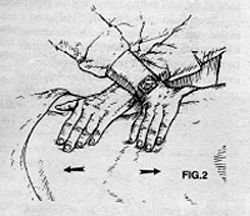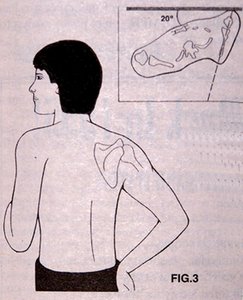
The shoulder girdle is a rather complicated structure to evaluate on plain films. Small fractures and mild degenerative changes can be overlooked on a standard shoulder series. Among the areas commonly overlooked or difficult to evaluate is the acromioclavicular joint, which is often "burnt out" or over-penetrated on the shoulder series.
Another area that is difficult to evaluate on a standard shoulder series is the glenoid fossa. It generally is overlapped by the head of the humerus. The good view for evaluating the glenoid is by positioning the patient as in Figure 2, where the patient is angled about 40o toward the side of interest and the central beam is directed toward the glenohumeral joint. Another structure which is difficult to evaluate is the scapula.
Figure 3 demonstrates the patient positioning for the trans-scapular or Y view of the shoulder. The patient faces the buckey and is rotated about 20o from the buckey, with the shoulder of interest closest to the buckey. The arm on the side of interest is slightly abducted and the elbow flexed. In other words, put the patient's hand on their hip. The central beam is directed toward the medial border of the protruding scapula. There are many more complicated views of the shoulder but these are very easy to perform, even if the patient is symptomatic. If there is still a question of pathology, even with these extra views, special studies may be necessary.
Deborah Pate, DC, DACBR
San Diego, California
Click here for more information about Deborah Pate, DC, DACBR.







